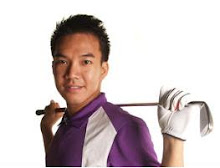Saturday, August 6, 2011
Wednesday, August 3, 2011
Golf secrets: what sets the pros apart? Sydney Morning Herald
A study of golf swings has identified the "X-factor" that separates pros and amateurs.
Players who possess the secret can hit the ball harder and longer.
In tests, 10 professional golfers were found to have a highly consistent peak X-factor of around 56 degrees during a hard swing. Each varied from this figure by no more than 7.4 per cent.
Their club speeds when hitting the ball were also consistent, varying by just 5.9 per cent from an average 127km/h.
In contrast three of the least skilled amateurs who took part in the study, a handicap 30 golfer and two novices, had peak X-factors of 48, 46 and 46 degrees respectively.
The smaller X-factor angles correlated with slower club speeds on impact of 109, 106 and 90km/h.
A number of other biomechanical elements were also measured, including the "S-factor" (tilt of the shoulders) "O-factor" (tilt of the hips), and "peak-free moment" (the golfer's turning force, or torque).
Writing in the Journal of Applied Biomechanics, the US scientists concluded that the X and S-factors together with peak-free moment were "essential to golf swing power generation among professional golfers". The X-factor was considered the "key" element.
Conrad Ray, head men's golf coach at Stanford University and one of the study authors, said: "One question that always comes from students is 'what starts the downswing?' People have had different answers. Some would say the hands, or others would say the shoulders or the lower body.
"But the study confirms that rotation of the hips initiates the downswing. So that, to me, is an interesting finding.
"All golfers want to know how to hit the ball longer, and this study supports that speed is really a factor of relative body rotation."
The findings could be used to help improve golfers' ability to hit the ball further without increasing the risk of injury, said the researchers.
Previous studies have shown that improper swing biomechanics is the leading cause of golf-related injuries.
An array of eight special-digital cameras were employed to gather data from the golfers at Stanford's Motion & Gait Analysis Laboratory.
The technology is normally used to analyse gait and upper limb movement disorders.
Three-dimensional motion images of golf swings were recorded from 10 professional and five amateur male players.
Most of the professionals were former members of the Stanford Men's Golf Team. The non-professionals were a college-level amateur with a handicap of four, two amateurs with handicaps of 15 and 30, and two novices.
Players who possess the secret can hit the ball harder and longer.
In tests, 10 professional golfers were found to have a highly consistent peak X-factor of around 56 degrees during a hard swing. Each varied from this figure by no more than 7.4 per cent.
Their club speeds when hitting the ball were also consistent, varying by just 5.9 per cent from an average 127km/h.
In contrast three of the least skilled amateurs who took part in the study, a handicap 30 golfer and two novices, had peak X-factors of 48, 46 and 46 degrees respectively.
The smaller X-factor angles correlated with slower club speeds on impact of 109, 106 and 90km/h.
A number of other biomechanical elements were also measured, including the "S-factor" (tilt of the shoulders) "O-factor" (tilt of the hips), and "peak-free moment" (the golfer's turning force, or torque).
Writing in the Journal of Applied Biomechanics, the US scientists concluded that the X and S-factors together with peak-free moment were "essential to golf swing power generation among professional golfers". The X-factor was considered the "key" element.
Conrad Ray, head men's golf coach at Stanford University and one of the study authors, said: "One question that always comes from students is 'what starts the downswing?' People have had different answers. Some would say the hands, or others would say the shoulders or the lower body.
"But the study confirms that rotation of the hips initiates the downswing. So that, to me, is an interesting finding.
"All golfers want to know how to hit the ball longer, and this study supports that speed is really a factor of relative body rotation."
The findings could be used to help improve golfers' ability to hit the ball further without increasing the risk of injury, said the researchers.
Previous studies have shown that improper swing biomechanics is the leading cause of golf-related injuries.
An array of eight special-digital cameras were employed to gather data from the golfers at Stanford's Motion & Gait Analysis Laboratory.
The technology is normally used to analyse gait and upper limb movement disorders.
Three-dimensional motion images of golf swings were recorded from 10 professional and five amateur male players.
Most of the professionals were former members of the Stanford Men's Golf Team. The non-professionals were a college-level amateur with a handicap of four, two amateurs with handicaps of 15 and 30, and two novices.



